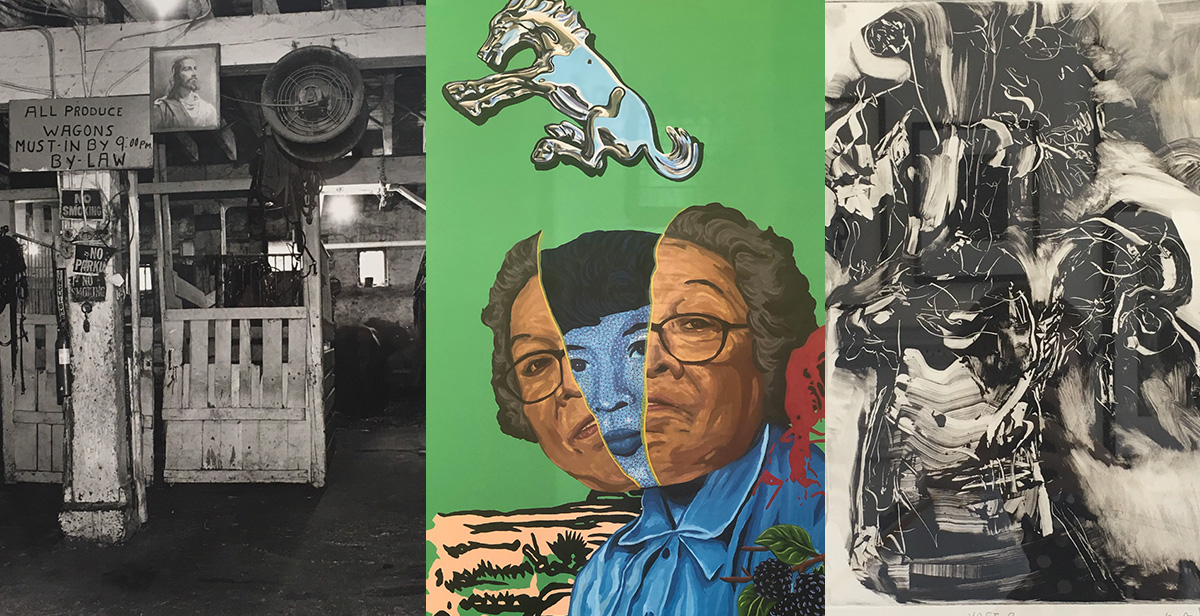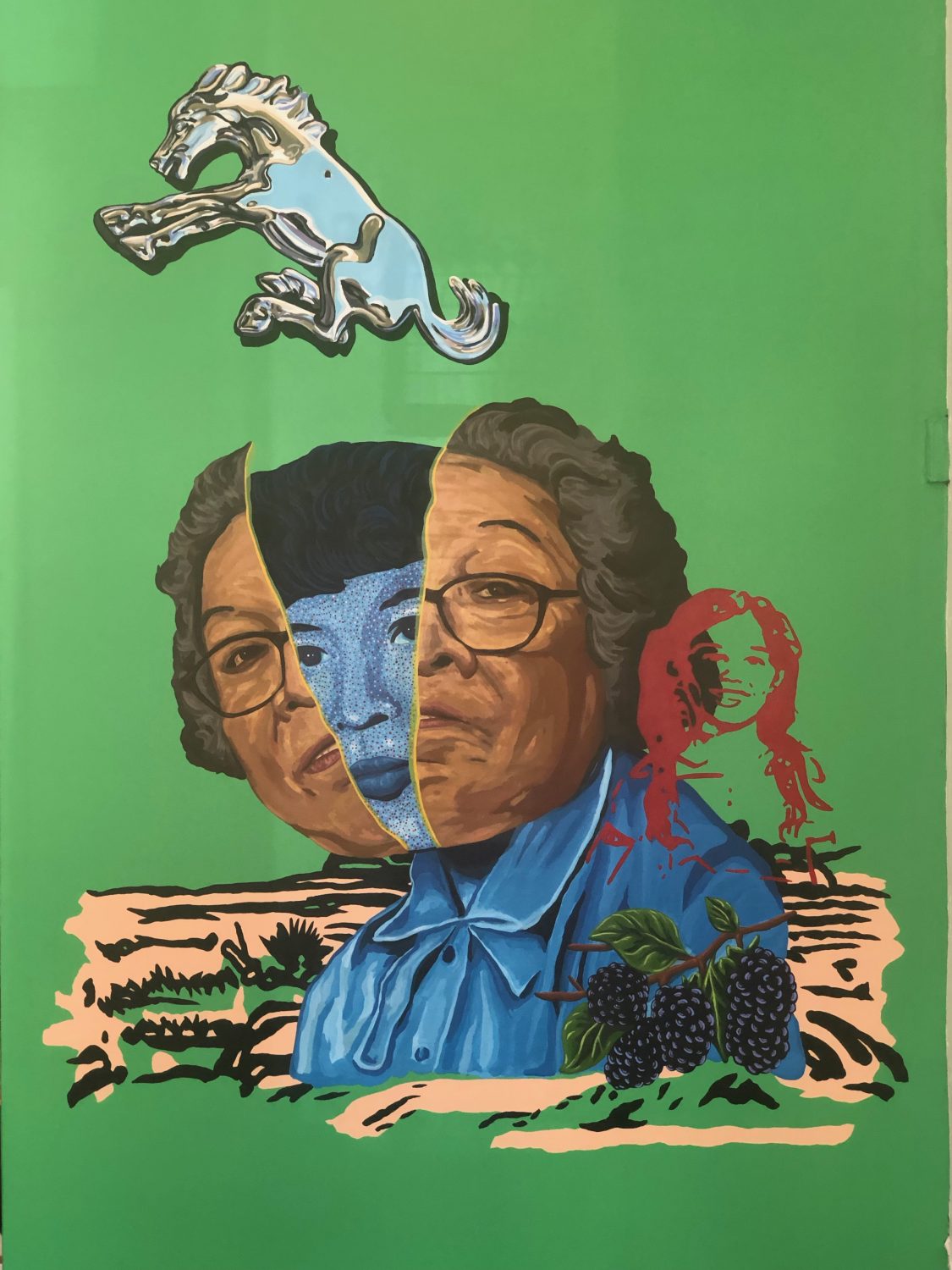This week: Photographer Roland Freeman’s intimate documentation of Baltimore arabbers at the Reginald F. Lewis Museum, the immigrant experience in Trump’s America at Transformer, and a salon-style print show at Ink Spot Press.
The Friday Gallery Roundup is a curated compilation of three short reviews of three current exhibitions worth your time and consideration. There’s so much to see and do in this town every day—check out our calendar and weekly picks for even more options—but here’s a doable list of shows you can check out now.
Roland Freeman
Roland Freeman’s Arabbers: Life in Baltimore Streets, through March 31
Reginald F. Lewis Museum, 830 E. Pratt St., Baltimore 21202
Hours: Wednesday–Saturday 10 a.m.–5 p.m., Sunday noon–5 p.m.
In September 1972, photographer Roland Freeman stood on 25th Street near Greenmount Avenue, pointed his camera west toward the setting sun, and snapped a photo of a silhouetted arabber, his horse and cart crossing the busy street. This photo has been stuck in my head since I saw it in this exhibition last week. I later thought perhaps it stayed with me because of its relative similarity to a phone pic I’d happened to snap—45 years later and just a few blocks north, right outside of my house—pointed west against the setting sun, looking toward my boyfriend as he patted the snout of a chestnut-colored horse yoked to an arabber’s cart, his day-end stock an orderly assortment of bananas, grapes, and cabbages.
The expert, windowlike composition framed by silky shadows in Freeman’s photo push incidental metaphors—the arabber, horse, and cart foregrounded but nearly swallowed in shadow, sunsetting—that make this photo series of Baltimore arabbers from the ‘70s and ‘80s feel both precious and urgent against the present day. The tradition of arabbing has dwindled over the years in part due to city shutdowns of arabbers’ stables. It is rare to see arabbers peddling fruits and vegetables around town, period, rarer still to see them on your own street.
The work on display here is from the photographer’s recent gift to the museum of over 100 photos from the series. Each image is intimate and highly specific, and begs for more context, like audio or text oral histories. One warm, candid interior features four children at the dinner table while their father reaches barehanded into a pot on the stove, another with six arabbers posed in front of the Kratz stable, some wearing Decker’s Salvage baseball caps and Jarvis Steel and Lumber T-shirts. Freeman came from a family of arabbers and was one himself for a time—his sensitivity to the people he photographed, their families, stables, and the streets they roamed shows the possibility and necessity of personal and community archiving. (Rebekah Kirkman)
Eliseo Angel Casiano, Gelare Khoshgozaran (foreground), Dhanashree Gadiyar (background)
where we came from & where we are going, through April 20
Transformer, 1404 P Street NW, Washington, DC 20005
Hours: Wednesday–Saturday, noon–6 p.m. and by appointment
Nestled among the grocery stores and restaurants of P street, Transformer’s storefront postage-stamp-sized gallery may be the smallest designated exhibition space mounting six shows a year in the greater Washington, DC area. A stalwart of the DC nonprofit art scene, Transformer was founded in 2002 by Jayme McLellan and Victoria Reis and continues to provide an essential platform for emerging artists, providing not only spaces to show their work (they regularly program shows and auctions outside of their storefront), but also professional development tools and programming.
The current show, where we came from & where we are going, examines the immigrant experience in Trump’s America. Curator Kimi Kitada’s proposal was selected from over 80 applications Transformer received for their first open call and it’s easy to tell why. Comprised of a single work each by five artists, the show is full without being overloaded. In the window, Dhanashree Gadiyar’s light paper piece recounts the story of a Malaysian immigrant she interviewed, each hand-cut letter and shape outlined by the negative space in which it is suspended. Arizona-based painter Eliseo Angel Casiano traveled to DC to paint Low Hanging Fruit, the mural on the back wall of the gallery, in four days. The site-specific piece combines symbols of the American Southwest with imagery of the artist’s own family members. On the floor, LED lit packages by Gelare Khoshgozaran pertain to the relationship between the artist and her Iran-based mother, a negotiation of screenings and checkpoints as a result of the U.S. sanctions on Iran.
Each of the works in the show is powerful independently, but together they present a chorus of stories about how immigrants experience the US and what it means to be fundamentally apart from a society you’re trying to live within. (Suzy Kopf)
First Workshop Show
Ink Spot Press, 943 N. Calvert St., Baltimore 21202
Hours: By appointment; visitors can text Ruth Channing ([443] 798-1167) or Ian Jackson ([830] 708-6424) to make an appointment
Artist Ruth Channing and her husband, the painter Raoul Middleman, bought this Mount Vernon home for a dollar in 1975. The basement has held Channing’s printmaking studio for about as long, and now that the couple have moved out, the bright front room houses Ink Spot Press’s First Workshop Show, a salon-style exhibition featuring prints by 10 artists, most of whose work has been printed in the studio.
More than any recognizable theme, feeling, or concept, the collaborative show emphasizes the collaborative nature of printmaking. But visual connections still arise as you glance around. Channing’s large print, “Bubble Net,” is meant to recall the artist’s experience of swimming among a pod of whales, the composition’s focus of unpredictably rippling circles was drawn with a whole-body gesture rather than one of the wrist, while blue and gray tones dapple across the paper like sunlight refracting through water. Several small prints by Richard Hellman, who works and helps out around the basement studio, use solemn, dark tones to depict oppressive storms and weather systems: tornadoes, waves, what looks like a massive wall of rain. There’s an impressive amount of meditative restraint in these images which could feel chaotic, but instead the implied havoc feels contained and controlled. A scribbly Raoul Middleman print offers immediate contrast, thin erratic lines springing, accumulating, popping and unwinding all over the paper; the eyes refocus and decipher in the center a three-headed Trump, each furious mouth open to a scream, reminiscent at once of triple-headed deities and the three-headed hellhound Cerberus. Dark-lit still life prints by the shop’s master printer, Ian Jackson, offer a quiet respite in their evident process of attempts and revisions, despite the ordinary subject matter. One of these prints would be entirely a velvety black rectangle if not for the spindly white lines elegantly scraped in the shape of vase holding flowers; another, though it’s the same object is vastly different, with a wider range of tones and textures moving all around the flowers and vase, like tiny spirits.
A few empty hooks also stand out on these walls. Channing says the gallery has a “cash and carry” policy; since most of the work is printed in the basement studio below, a buyer can take the work home with them as soon as they purchase it. (RK)
Images from Transformer by Suzy Kopf; all others by Rebekah Kirkman.












